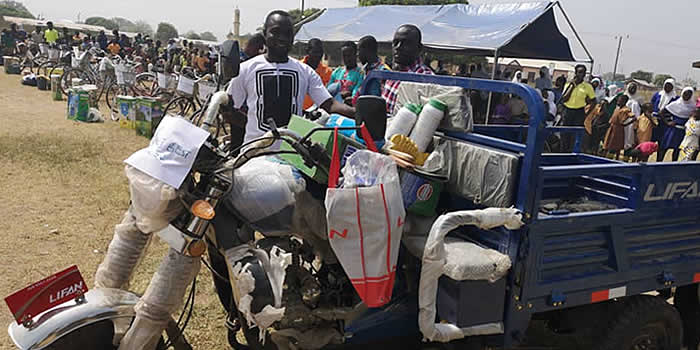

The district has limited health infrastructure and personnel. Health facilities include Health Centres at Buipe and Mpaha and Health Posts at Yapei and Kusawgu. There are also rural Clinics at Sankpala and Chama. Health personnel are limited to two Medical Assistants, seven midwives, nine nurses and five Community Health Nurse.
The top ten ailments are malaria, diarrhea, UTRI, skin diseases, pneumonia, typhoid, Kwashiorkor, anemia, intestinal worms, and guinea-worm. HIV/AIDS cases are also prevalent and on the increase. The National Health Insurance Scheme (NHIS) has taken off in the district with over 30% of the people joining the scheme.
The scheme has come as a great relief to many of the people who could not afford direct payment for health services. Traditional Healers and Traditional Birth Attendants (TBAs) provide complementary services to the orthodox medical care.
Top Ten Outpatient Illnesses | ||||||
| Buipe |
| Mpaha Health Centre | |||
No. | Condition | No. | % | Condition | No. | % |
01 | Malaria | 1,593 | 43.6 | Malaria | 3,497 | 63.3 |
02 | Diarrhea Diseases | 530 | 14.5 | ARI | 588 | 10.7 |
03 | Home/Occupational Accidents | 397 | 10.9 | Anaemia | 382 | 6.9 |
04 | Skin Diseases Ulcers | 351 | 9.6 | Diarrhea Diseases | 278 | 5.0 |
05 | Other ARI | 159 | 4.3 | Skin Diseases | 231 | 4.2 |
06 | Pneumonia | 148 | 4.0 | Pneumonia | 217 | 3.9 |
07 | Rheumatism & Joint Pains | 134 | 3.7 | Typhoid Fever | 124 | 2.2 |
08 | Acute Ear Infection | 123 | 3.4 | Hypertension | 96 | 1.8 |
09 | Other Oral Conditions | 112 | 3.1 | Rheumatism | 77 | 1.4 |
10 | Acute Eye infection | 107 | 2.9 | Acute Eye infection | 35 | 0.6 |
| TOTAL | 3,654 | 100 |
| 5,525 | 100 |
Access to Healthcare, Malaria Control and Prevention of HIV/AIDS
The District Health Directorate of the Central Gonja District aims at improving the health status of the people in the District through the promotion of quality health services that are accessible and affordable to the people. In this regard, the Assembly is working closely with the Health Directorate to achieve this objective.
Reproduction and Child Health Vision
The District Health Directorate’s vision is to improve child and maternal nutrition through interventions such as food security, supplementary feeding and improved personal and environmental sanitation. In this regard, children in the district especially girls would have access to basic functional education and adequately equipped with maternal and child health knowledge, quality and affordable health services to all households in the 252 communities in the district. Furthermore, health standards in the district would improve especially transport system for timely referrals, improved environmental sanitation and potable water. The CHIPS system will ensure full implementation of the National Health Insurance Scheme (NHIS) to enjoy hundred percent child survival with adequate knowledge in IMCI and ACSD management.
Pregnant women would have TT2+ and a third dose of IPT before delivery and maternal Vitamin A after delivery and postnatal service. The district would have had skilled staff and a decent district hospital with well-equipped functioning medical equipment for obstetric emergencies.
Vision on Maternal Health
- By the year 2015, all residents (especially women) in the Central Gonja District would have access to at least functional education and adequate information on maternal health and childbirth issues through the provision of adequate health infrastructure and quality services to all households and communities.
- Community members would see maternal death issues as a serious setback, make transport available and ensure a fully developed CHPS & CBS system that will capture vital events in the communities for analysis, interpretation and planning purposes.
- Priority attention would be given to support policies on maternal health issues. The District would also adopt health related communication messages to communities, households and ensuring an enabling environment for emergency care delivery.
Vision on Child Health
By the year 2015, when the National Health Insurance Scheme (NHIS) would be well-functioning in the Central Gonja District, all staff in public health facilities would have been well trained to practice clinical IMCI, and all children (0-5years) immunised regularly against vaccine preventable diseases at regular intervals. Also, child nutrition and growth monitoring would be a key priority area with all defaulters traced, and two yearly deworming carried out in all households and communities. Measures will be taken to educate and empower women financially, ensure good nutritional status of children and families through household food security.
Factors Contributing to High Mortality and Morbidity
Socio-economic factors
- Low literacy rate among women
- Low level of women empowerment
- High poverty levels
- Poor health seeking behaviours
- Polygamy
- The women place is the kitchen
- Women should not take decision
- Women have limited sexual rights
- Harmful traditional practices
The Health System
- Inadequate infrastructure
- Poor access to quality material health services e.g. at the community level
- Poor access to emergency obstetric care
- Poor referral system
- Inadequate staff
- Low motivation
Policy Thrust and Key Priorities
The thrust for service delivery in the district is based on the five (5) pillars of the Ministry of Health/Ghana Health Service. Thus:
- Increase access (financial and geographical)
- Improving quality of service
- Ensure efficiency
- Collaboration with partners
- Financing health service delivery
The Key Priorities for the District
- Increase access to health care especially the hard to reach areas
- Intensify guinea worm eradication programme
- Improve quality of care in all health facilities
- Intensify disease surveillance activities
- Improve efficiency in service delivery
- Improve upon preventive maintenance of facilities and vehicles
- Management of some diseases. E.g. TB and Yaws
- Capacity development of staff
- To lobby with the district assembly to implement the National Health Insurance Scheme (NHIS) in the district by showing readiness
Objectives and Targets for Maternal Health
By December 2006,
- 60 Percent of pregnant women will be receiving skilled maternal attendance and babies receiving immediate neonatal care
- 30 percent of pregnant women will receive family planning services
- 50 percent of pregnant women and children under five sleeping under Insecticide Treated Nets (ITNS)
- 50 percent of the proportion of women with obstetric complications needing EOC referred promptly
- 60 percent of women receiving at least two doses of tetanus texiod vaccine
- 50 percent of pregnant women receiving full dose of intermittent Preventive Treatment (IPT 3 doses) for malaria
By December 2010
- 80 percent of eligible mothers and children in Ghana will be receiving all interventions listed above.
Objectives and Targets for Child Health
By December 2006
- 60 percent of children less than five years suffering from diarrhoea receiving ORT.
- 60 percent of pregnant women and children less than five years sleeping under insecticide treated nets
- 60 percent of children under five years suffering from malaria receiving timely and appropriate anti malaria treatment drugs
- 80 percent of children 12-23 months are fully immunized.
- 80 percent of children nine (9) months immunized against measles
- 60 percent of children 6-59 months old receiving vitamin A supplements twice a year.
- 60 percent of infants exclusively breastfed for six months
- 70 percent of infants 6 months old receiving timely complementary Breastfeeding
By December 2010:
- 80 percent of all eligible mothers and children in Ghana will be receiving the intervention listed above.
Malaria Control
Malaria is the single most important cause of mortality especially children under five (5) and pregnant women in Ghana. Statistics from the various health centers in the district shows that the most prevalent of all our patient cases reported was malaria with women and children, the vulnerable recording a higher rate. The Central Gonja District being agric-based and malaria puts a heavy burden on the Human Resource potentials of the District with it’s attendant negative effect on economic development.
Efforts are however being made by the District Health Directorate in collaboration with the District Assembly to improve access to health care. The DEHO is leaving no stone unturned to ensure a sound and healthy environment in the district. Some of the strategies and objective are sensitization and clean-up campaigns.
The District Assembly which has been mandated to ensure a holistic development of the district is channeling a percentage of the DACF for health related activities in the District. In its development efforts, the District Assembly has constructed a health centre in Buipe, Yapei, Kusawgu and Mpaha. It also provided Nurses quarters in Buipe and Mpaha and launched a CHIPS compound in Sankpala .The additional CHIP ZONES are yet to be launched in Boachipe, Yala and Chama. The District Assembly also sponsored some health related trainees and a Medical student in various educational institutions.
Interventions
- Fair distribution of health personnel district wide
- Improve access to quality health care through the provision more CHIPS compound in the district.
- Sponsor more health related trainees in the district.
- The District Assembly and Donor partners to support the District Health Directorate in the organization of health and sanitation durbars in the district on health related issues
- Sensitize members of the community on the use of insecticide treated mosquito bed nets and subsidize price of the nets in order to roll back malaria in the district.
- Institute best worker award.
Date Created : 11/17/2017 4:58:25 AM











 facebook
facebook
 twitter
twitter
 Youtube
Youtube
 +233 593 831 280
+233 593 831 280 0800 430 430
0800 430 430 GPS: GE-231-4383
GPS: GE-231-4383 info@ghanadistricts.com
info@ghanadistricts.com Box GP1044, Accra, Ghana
Box GP1044, Accra, Ghana